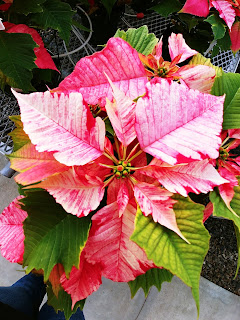Poinsettia Care and Re-bloom
If your poinsettia is wrapped you will want to make holes in the bottom of the wrap to allow proper drainage. Or, after watering, wait 30 minutes and pour the excess water out carefully.
Water your poinsettia thoroughly then allow drying a bit before watering again. Poinsettias love light and dislike breezy locations. Water every 5-7 days. I like to feel the weight of the pot to determine if it needs water.
Enjoy your new poinsettia for
the holidays.
JANUARY- MARCH
Be careful not to over-water and give it plenty of light.
APRIL
Prune back your poinsettia and fertilize.
MAY – SEPTEMBER
Allow your poinsettia to get plenty of bright light. You
may put your poinsettia outside in a protected area, to begin with, and then
gradually move it to full sun if you wish, so that it gets plenty of light.
Continue to water regularly and fertilize. You may want to pinch the top out of
the poinsettia to encourage more branching before September.
SEPTEMBER – NOVEMBER
You will want to begin to shorten the light exposure for
your plants. Bring them inside, place a cardboard box over them or put them
into a closet at night and increase their dark time to 12 hours per night. Be sure the plants get plenty of light in the day. When the bracts begin to color, you do not need to keep it dark at night. Do not fertilize after the
bracts show good color.
 ENJOY YOUR POINSETTIA
FOR ANOTHER HOLIDAY SEASON!
ENJOY YOUR POINSETTIA
FOR ANOTHER HOLIDAY SEASON!











































